
|
|
|
Table of Contents
Europe
Major Geographic Qualities1. western extremity of Eurasia 2. many industrial resources 3. lingering world influence 4. high degrees of specialization 5. manufacturing dominance 6. numerous nation-states 7. urbanized population 8. aging and declining population 9. high standards of living
Physical Characteristics1. peninsula of peninsulas: A peninsula is a piece of land surrounded by water on three sides. Europe is a peninsula of the Eurasian supercontinent. Its main peninsulas are the Iberian, Italian, Crimean and Balkan, located in southern Europe, and the Scandinavian and Jutland, located in northern Europe.
2. Europe can be divided into four major physical regions, running from north to south: Western Uplands, North European Plain, Central Uplands and Alpine Mountains. a. western uplands: geologically older, lower, more stable than Alpines … curve up the western edge of Europe and define the physical landscape of Scandinavia (Norway, Sweden, Denmark), Finland, Iceland, Scotland, Ireland, the Brittany region of France, Spain, Portugal … defined by hard and ancient rock shaped by glaciation, abundant marshlands, lakes, fjords
b. north
European lowlands: lengthy arc (aka Great European Plain) of rivers and
waterways, most densely populated region of Europe, agriculture, industries …
extend from the southern UK east to Russia and includes parts of France,
Belgium, the Netherlands, Germany, Denmark, Poland, the Baltic states (Estonia,
Latvia, Lithuania), Belarus … mostly lies below 500 feet in elevation, home to
many navigable rivers (Rhine, Weser, Elbe, Oder, Vistula), climate supports wide
variety of seasonal crops … allowed for early communication, travel,
agricultural development, avenue for migration c. central uplands: heart of Europe, hills, low plateaus, raw materials (iron, coal, other resources for manufacturing) … east-west across central Europe and include western France and Belgium, southern Germany, Czechia, parts of northern Switzerland and Austria … lower in altitude and less rugged than the Alpine region and heavily wooded ... sparsely populated except in the Rhine, Rhine, Elbe and Danube river valleys d. alpine system: highland region, spine of Europe … includes ranges in the Italian and Balkan peninsulas, northern Spain, southern France … includes the mountains of the Alps, Pyrenees, Apennines, Dinaric Alps, Balkans, Carpathians … high elevations, rugged plateaus, steeply sloping land, active volcanoes, such as Mount Etna and Mount Vesuvius in Italy
3. diverse physical geography a. complex geology with newest and oldest formations b. latitudinal extent (from Arctic to Mediterranean Subtropics) c. modification of latitudinal controls by land and water interaction i. marine (maritime) influence ii. continental influence (continentality) d. thousands of years of human occupation caused changes (human-environment interaction)
Cultural Characteristics1. Europe has a long history of human development and is considered the birthplace of Western Civilization: the result of classical civilizations, Christianity, the Renaissance and Reformation, the Enlightenment, and the Industrial and Scientific Revolutions a. Greece: philosophy, democracy, roots of science, art and architecture b. Rome: law, engineering, infrastructure (city structure, roads and aqueducts), establishment and spread of Christianity, areal functional specialization
2. The Roman Empire’s cultural influence remains to this day. French, Spanish, Romanian and modern Italian derived from Latin. Roman fondness for wine brought vineyards to France. The empire laid the cornerstones of many of today's modern cities (such as Paris), and invested in the infrastructure that was vital for their longevity.
3. Agrarian Revolution: began in Europe in 1750s, based on new agricultural innovations, enabled increased food production, enabled sustained population increase
4. Industrial Revolution: developed in UK between 1750-1850, evolved from technical innovations that occurred in British industry, proved to be a major catalyst toward increased urbanization, produced a distinct spatial pattern in Europe, greatly altered many kinds of relationships, countries within the region have a history of interaction among themselves
5. Political Revolution: Treaty of Westphalia in 1648 (key step in evolution of state system) ended decades of war, French Revolution, Revolutions of 1848, rise of socialist thinking
6. multi-ethnic and multi-cultural a. resulted from migration and cultural diffusion (the spreading of culture) … more than 160 ethnic groups, over 60 languages spoken b. Some countries have only one major ethnic group, such as Sweden (share common language, culture, religious heritage). Some, like Belgium, have two major ethnic groups - the Flemings and the Walloons - share a common religion, but do not speak the same language. Some, like Switzerland, have multiple languages spoken (French, German, Italian, Romansch). c. Multiculturalism can be a source of tension: Multi-ethnic rivalries (Albanians, Bosnians, Croats, Serbs) within the former country of Yugoslavia have caused bitter conflict. This area is often called a shatter-belt because the once communist country split into five separate countries. Even after the split, ethnic differences still cause fighting and conflict. These ethnic groups have followed a policy of ethnic cleansing (expelling or killing an entire ethnic group), leading to thousands of deaths and refugees.
7. key
European cultural traits a. political system: commitment to democracy where the leaders rule only with the consent of the population b. legal system: Napoleonic Code derived from Roman Law c. economic system: commitment to capitalism or market economy d. industrialization and urbanization e. government services: education, medical and health care, retirement
8. Europe’s culture has spread world-wide through exploration, colonization, imperialism, immigration, trade
Demographic Characteristics1. falling share of world’s population but continues to experience slow natural growth (birth rates lower than death rates; immigration prevents population loss)
2. in
last stage of Demographic Transition (or beyond): women in workforce,
widespread contraception, shortage of affordable housing, some countries offer
incentives
3. high per capita GDP, literacy rate, life expectancy
4. fewer young people
5. smaller, well educated working age population
6. age-dependent boom and bust: A higher ratio of young dependants usually correlates with increased poverty. Countries with rapid declines in fertility have benefited from the demographic dividend and falling dependency ratios. A fertility rate of about 2.1 is needed for long-term stabilization but few countries have been able to stop the fertility decline at that point as individuals (especially women) realize the advantages of having fewer children. At a lower fertility rate, future growth is much harder to achieve and several countries face future aging shocks. The consequences of both too many and too few babies show up in dependency ratios – the young and old dependent on those of working age. While today’s problem for developing countries is the high level of poverty due to high fertility, tomorrow’s problem will be avoiding a decline in living standards in countries with aging populations and declining workforces. Northern Europe, France and the UK have in varying degrees tried to avoid it with programs such as job protection and generous leave for pregnant and nursing mothers, government funding of nursery schools, direct child support payments and other measures to reduce the economic opportunity costs of childbearing. They see this as investment in the future workforce, not just welfare cost. (If you’re interested, read From demographic boom to dependency bust.)
7. Immigration was welcomed for a long time because there was a labor shortage. In recent years, economic and cultural differences have led to problems between "old" and "new" Europeans. a. scarce jobs should go to Europeans first b. concerns about international terrorism c. concern about dilution of national culture d. immigration may be only way to solve labor shortage, workers needed to keep up tax revenues and support retirees e. EU working to establish common immigration policy: guest workers (migrant workers from other countries, usually doing low-wage work), called gastarbeiter in Germany (mostly Turks), other European countries have migrants from their former colonies, additional migration from Eastern to Western Europe
8. highly urbanized a. Medieval Landscape (900-1500 CE): densely settled, buildings next to streets, green space only near churches and public squares b. Renaissance-Baroque (1500-1800): wider streets, large gardens, monuments, more open space, ornate architecture c. Industrial (1800-present): walls and fortifications removed, factories and industrial areas build on edge of cities, urban sprawl developed
Economic Characteristics1. birthplace of the Industrial Revolution … started in England following the discovery of coal and iron ore
2. age of advancements in making machinery and in new methods of production … led to a rise in industrial capitalism: an economic system in which business leaders seek to expand companies and maximize profits
3. Industrial Revolution led to a prosperous middle class of merchants and factory owners (but factory workers were underpaid and lived in overcrowded, unhealthy conditions).
4. use advanced farming techniques which gives them high crop yields
5. well developed infrastructure
6. Supranationalism is a venture involving three or more states cooperating politically, economically and/or culturally to promote shared objectives. A supranational union is a type of multinational political union where negotiated power is delegated to an authority by the governments of member states so that the organization has power over the states. The concept of a supranational union is sometimes used to describe the European Union, as a new type of political entity. The EU is the only entity which provides for international popular elections, going beyond the level of political integration normally afforded by international treaty.
7. European
Union (EU): original
Members Belgium, Denmark, France, Germany, Greece, Iceland, Italy, Luxembourg,
Netherlands, Portugal, Spain, UK … goal to coordinate policy among members in
economics, defense, justice and home affairs a. The EU is an economic and political confederation of 28 member states (as of 2016) located primarily in Europe. It operates an internal (or single) market which allows free movement of goods, capital, services and people between member states. b. The EU operates through a system of supranational independent institutions and intergovernmental-negotiated decisions by member states. c. The EU provides for free movement of workers and capital, a single market and a common currency (euro). In effect, Europe has become one large unified market. d. problems: loss of autonomy, disparities in levels of economic development, technical barriers, cultural barriers e. Macron’s New Europe (the European Political Community) Debuts in the Shadow of War
8. progressive approach to environment a. Agriculture, resource-extraction, industrial manufacturing, urbanization create air and water pollution and acid rain. b. Western Europe is one of the world’s greenest regions because of pro-environment policies since 1970s. c. European voters support environment in Europe and globally, including reduction of greenhouse gases. d. Eastern Europe neglected its environment under Soviet-style economics; Soviet-designed nuclear plants may be dangerous. e. Difficult to solve Eastern Europe’s environmental problems due to ongoing economic and political evolution.
Political Characteristics
|
|
|
per 100 |
||||||
|
Armenia |
0.28 |
41 |
78/70 |
61.9 |
3,622 |
3.4 |
70.5 |
|
Belarus |
-0.15 |
43 |
77/65 |
74.9 |
8,014 |
1.6 |
59 |
|
Georgia |
-0.5 |
46 |
78/71 |
58 |
4,097 |
4.8 |
48.9 |
|
Moldova |
-0.15 |
35 |
75/67 |
37.9 |
1,951 |
4.4 |
46.6 |
|
Russia |
-0.01 |
43 |
76/64 |
73.2 |
12,898 |
0.6 |
70.5 |
|
Ukraine |
-0.44 |
43 |
76/66 |
69.5 |
2,929 |
-6.8 |
43.4 |
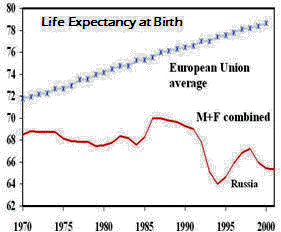
4. population decline:
Russia is facing a demographic dilemma today. The population of Russia has
dramatically declined since the collapse of the Soviet Union. At the time of the
breakup (1991), Russia had a population close to 150 million (about half that of
the US). Today, the population stands at around 140 million despite the
immigration of thousands of Russians from the near abroad (the
newly independent republics that emerged after the dissolution of the Soviet
Union).
The birth rate has dropped sharply, albeit temporarily, at times but is fairly stable long term. (Economic uncertainty seems to be a factor persuading people against having children.) It’s the increasing death rate that is the cause of the declining population. The reasons behind the increase in the crude death rate are such things as alcoholism, drugs, suicide, industrial accidents, diseases, violent crime, etc. Those things may stem from the difficulties associated with the political transition and subsequent economic uncertainties. (Check out the population pyramids below.)
The trend is more pronounced in males than in females. For example, in 1991 the life expectancy for males was 71 years. Today it has dropped to 59. If the present trends continue Russia will have a population of only 100 million by the year 2050. (It should be noted that other ethnic groups in Russia are not experiencing these same dramatic declines.) If this present trend continues then we may see a resurgence within Russia of xenophobia and a subsequent rise in Russian nationalism.
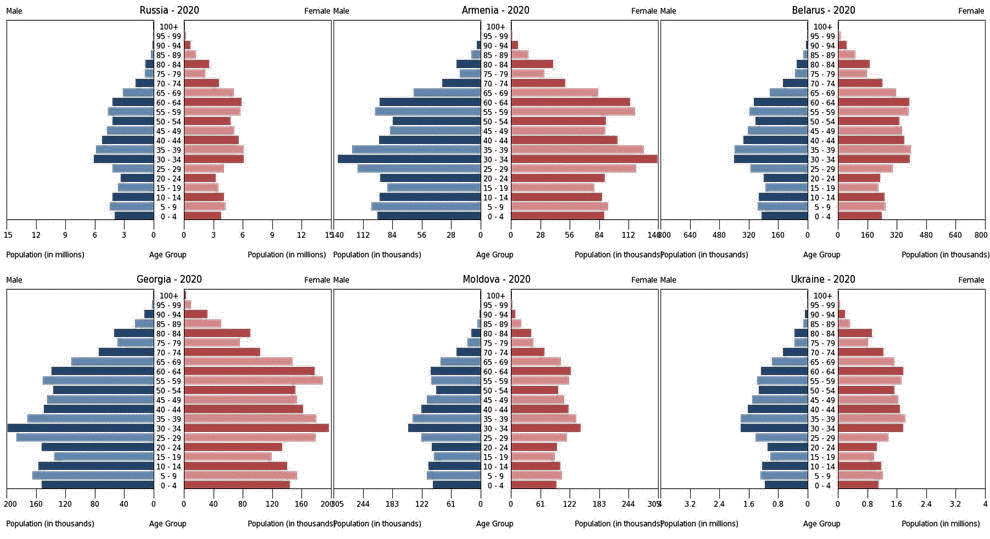
5. problems:
suicide, lifestyle choices (smoking, alcoholism, drug abuse, poor diet), poor
health care (medical facilities still owned by the government are inefficient),
out-migration
6. inside the Russian city: Russian cities are carefully planned in form and function, with circular land-use zones.
a. Core has superior transportation, and the best stores and housing. Core predates Soviet era.
b. sotzgorods: work-linked housing, including dorms
c. chermoyuski: apartment blocks from 1950s-1960s
d. mikrorayons: self-contained housing projects of 1970s-1980s
e. dachas: country houses available only to the elite
 Economic
Characteristics
Economic
Characteristics1. wealth of natural resources: rich soils in some areas, timber, metals, precious gems, energy resources (fossil fuels), manufacturing food products, telecommunications, consumer goods … Resources and industries are poorly managed, however, and widely dispersed, with many in remote Siberia.
Most problems with resources have to do with climate and distance. For example, oil and gas exist in abundance in the West Siberian Plain. Very cold temperatures in the winter and swampy / marshy conditions in the summer make accessing the resource difficult. (Soggy conditions in the summer are the result of upper layers of frozen soil thawing and ice break-ups along southern portions of rivers. Ice flows in the north where rivers are still frozen create ice jams and flood surrounding land.)
2. market economy: The levels of industrialization at the start of the Soviet era were among the lowest in Europe. The region worked hard to catch up with the West but the result was inefficiency and extremely high levels of pollution. Since the dissolution of the Soviet Union, the region has had extremely rapid political and economic change: from a centrally planned economy to attempts at capitalism, and from authoritarian dictatorship to democracy.
Russia removed price controls in 1992 and sold its state-owned businesses to private investors in 1993. Higher prices and the lack of legal safeguards have created problems. (Russia has attempted to create a market economy but has not provided the structure needed for it to succeed – private property protection, rule of law, etc.) Agriculture still struggles, in part due to the harsh climate and landforms. Many people see little economic gain from the changes.
Many Russians reinvested their money in other countries rather than in Russia. The region has struggled to attract foreign investment but investors are wary due to post-Soviet periods of instability. Most investments come from the US and Western Europe (especially Germany and the UK). In recent years, foreign investment has grown by 14% annually.
The rest of the region has replaced its communist systems with a mix of state-run operations and private enterprise. The independent republics negotiate for needed resources with Russia and each other rather than accept centralized control but Russia continues to dominate the region’s economies.
3. trade: developed partnerships with other countries for trade but few exports … became member of APEC (Asia-Pacific Economic Cooperation) in 1998 … international relations growing, loans from other countries
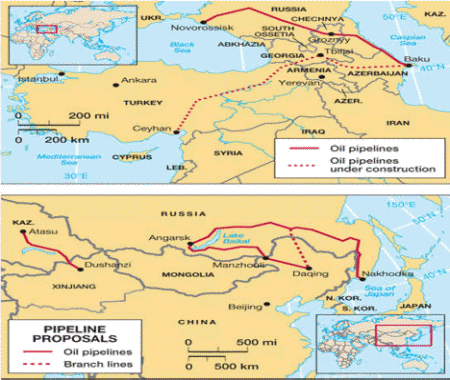
4. industrial resources: #1 in petroleum extraction and processing … crude oil, iron ore, manganese, nickel
5. manufacturing capacity: steel, heavy machinery, agriculture equipment
6. transportation infrastructure
a. longest coastline but frozen year-round
b. transporting goods: roads aren’t good, especially in Siberia … depend mostly on railroads and waterways for transportation
c. transporting people: railroads are most common … many people do not own cars, use public transportation … airlines very expensive
d. transporting energy: pipelines for natural gas and oil
e. mass communications: Soviet Union controlled all of this … private ownership has grown
7. inherited a legacy of environmental problems (poor water, soil, air quality … nuclear waste and dangerous nuclear plants) … During Soviet rule, government only cared about power and not damage to the land. Russia must now use their natural resources without causing similar damage and repair the damage already done.
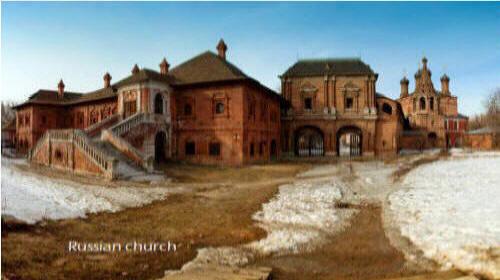
1. emergence of a commonwealth of Slavic countries to replace Soviet Union
2. globalization: The future of the region is in many ways tied to the unpredictable global energy economy. During the Soviet era the region was largely isolated from the rest of the world. Global linkages have increased in the post-Soviet period. The strongest link between Russia and the outside world is an economic one and is tied to oil and gas. Russia has 35% of the world’s natural gas reserves (Siberia). Russia is the largest non-OPEC oil producer and second largest exporter of oil. Pipelines are thus important and play a role in the politics of the region.
3. The region’s economy is currently weak, commitment to democracy is uncertain and nationalist movements threaten stability. The transition has been difficult but it continues for now.

a. Russia is so immense it’s difficult to imagine. It’s one-sixth of earth’s landmass, spans 11 time zones and is twice the size of the US or China. There are a number of challenges related to its vast size.
i. distance decay: Increasing distance between places tends to reduce interactions between places. In the case of Russia, effective government control is often times reduced farther from Moscow.
ii. There are thousands of miles of border to monitor and defend and multiple neighbors.
iii. Many different ethnic groups live in Russia. Many administrative regions are based on ethnicity. Many of these groups dislike Russians or the power base in Moscow and would like to govern themselves independent of Russia.
iv. Vast size means that huge distances must be overcome in transportation and communication.
v. Russia is a fragmented state (Kaliningrad: former German territory obtained after WWII).
vi. In addition, many Russians live outside Russia. During the Soviet era, the state pursued a program of Russification (sending Russians to live in non-Russian areas). After the break-up of the Soviet Union, some Russians found themselves aliens living in a foreign country.
vii. Putin’s Empire Starts to Crumble (09/27/22)
b. Eastern Frontier (manufacturing regions)
East of the Urals, in south-central Russia, is Russia’s Eastern Frontier, a region of planned cities, industrial plants and raw-material processing centers. The population is centered in two zones here: the Kuznetsk Basin (or Kuzbas, for short) and the Lake Baikal region.
The Kuzbas is a region of coal, iron ore and bauxite mining; timber processing; and steel and aluminum production industries. Central industrial cities were created across the eastern frontier to take advantage of these resource opportunities.
Agriculture, timber and mining are the main economic activities in the eastern Lake Baikal region, which is more sparsely settled than the Kuzbas. Some of the longest river systems in the world flow through the eastern frontier.
c. Siberia (oil and gas regions)
Stretching from the northern Ural Mountains to the Bering Strait, Siberia is larger than the entire United States (5.2 million square miles) but is home to only about fifteen million people. Its cities are located on strategic rivers with few overland highways connecting them.
Type D (continental) climates dominate the southern portion of this region, and the territory consists mainly of coniferous forests in a taiga biome, one of the world’s largest taiga regions. Type E (polar) climates can be found north of the taiga along the coast of the Arctic Sea, where the tundra is the main physical landscape. No trees grow in the tundra because of the semi-frozen ground. Permafrost may thaw near the surface during the short summer season but is permanently frozen beneath the surface. On the eastern edge of the continent, the mountainous Kamchatka Peninsula has twenty active volcanoes and more than one hundred inactive volcanoes. It is one of the most active geological regions on the Pacific Rim.
In the west, abutting the Ural Mountains, is the huge West Siberian Plain, drained by the Ob and Yenisey rivers, varying little in relief, and containing wide tracts of swampland. East of the Yenisey River is central Siberia, a vast area that consists mainly of plains and the Central Siberian Plateau. Farther east the basin of the Lena River separates central Siberia from the complex series of mountain ranges, upland massifs and intervening basins that make up northeastern Siberia (i.e., the Russian Far East). The smallest of the four regions is the Baikal area, which is centered on Lake Baikal in the south-central part of Siberia.
Siberia does not get warmth from the Atlantic Ocean because of the barriers of Europe and the Ural Mountains, or from the warmer climes of Central Asia because of the mountains to its south and the mountains of the Russian Far East. The only side of Siberia which is not blocked off by a geographical barrier is the north, opening up the area to the bitter cold of the Arctic Ocean. To add to these disadvantages, most of Siberia's soil is acidic podsol, which is not a good match for agriculture. However, there are rich, fertile black earth belts in the southwest (known as chernozem), as well as scattered pockets of rich land in other parts of southern Siberia. Despite the many drawbacks for cultivating Siberia lands, there exists a multitude of rivers and lakes that can be put to use for irrigation.
The vast northern region of Russia is sparsely inhabited but holds enormous quantities of natural resources such as oil, timber, diamonds, natural gas, gold, and silver. There are vast resources in Siberia waiting to be extracted, and those resources will play an important role in Russia’s economic future.
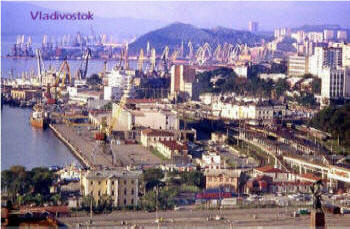
d. Far East
Across the strait from Japan is Russia’s Far East region, with the port of Vladivostok as its primary city. Bordering North Korea and China, this far eastern region is linked to Moscow by the Trans-Siberian Railway. Before 1991, Vladivostok was closed to outsiders and was an important army and naval base for the Russian military. Goods and raw materials from Siberia and nearby Sakhalin Island were processed here and shipped west by train. Sakhalin Island and its coastal waters have oil and mineral resources. Industrial and business enterprises declined with the collapse of the Soviet Union in 1991. Today, the far east is finding itself on the periphery of Russia’s hierarchy of productivity. However, it has the potential to emerge again as an important link to Pacific Rim markets.
e. Moscow and St Petersburg (Leningrad): two largest cities and capital cities
f. Russian Mafia: There are estimates that the Russian mafia controls 40% of the private economy and 60% of the state-run enterprises. Up to 80% of the banks in Russia may be under mafia influence. The result has been corruption and the expectation of paid protection. The Russian mafia has expanded globally: money laundering (Russia, UK, US), gambling (Sri Lanka), drugs (Colombia), legitimate Israeli high tech companies.
g. the
Ruble Rules: Russia uses economic clout in the region for political
purposes. For example, Russia gave Ukraine a substantial discount price on the
natural gas Ukraine buys from Russia when Ukraine agreed to ditch a pact with
the European Union in favor of closer ties with Moscow. Three months later,
Russia said Ukraine had been too lenient on groups protesting the EU rejection,
raised rates some 40% and threatened to retroactively demand Ukraine pay the
higher price for the previous 3 months’ gas. This is far from a unique
situation.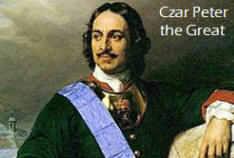
h. Russian imperial ambitions date back to the 16th century when the Grand Principality of Moscow, or Muscovy, proclaimed itself the Third Rome, the successor of the Byzantine Empire and the protector of all Orthodox Christians. The Russian imperial army fought numerous wars in the east, west and south, and by the mid-19th century, Russia had become the largest land empire. Along with the British, Austro-Hungarian and French empires, it saw itself and presented itself as a European colonial power. The logic of internal colonization, which has deep roots in the nineteenth and twentieth century, convinced Russia’s rulers that it was necessary to take over Russia’s expanses and protect them. By extension, the country had to insulate itself from external influences for the sake of its obsession with security. Wars often served to compensate for the Russian inferiority complex, which stems primarily from the country’s perennial economic backwardness. The concept of a heroic death for the homeland is deeply embedded in Russian culture. Quite often, however, wars only exacerbated feelings of national humiliation and resentment, and a thirst for revenge, especially after defeats.

Following the 1917 Marxist revolution, the new Soviet Union proclaimed the end of the Russian monarchy and Russian imperialism, but it fought brutally to preserve the Russian imperial borders. During the Soviet Union’s post-WWI imperial restoration phase, it re-conquered newly formed independent countries - such as Ukraine, Georgia, Armenia and Azerbaijan - which emerged after the collapse of the Russian Empire. In the early 1930s, Soviet leader Joseph Stalin embraced Russian nationalism based on the old imperial myth of the greatness of the Russian people. Moscow made ethnic Russians the most privileged group in the Soviet Union and sent Russian settlers to populate and control non-Russian regions. Purging native leaders, forcefully resettling entire ethnic groups and creating conditions that led to mass deaths were all part of Soviet colonization. Non-Russian people’s cultures, languages and histories were disparaged while Russification was presented as enlightenment. Stalin was obsessed with maintaining Russian imperial borders and had adopted the same methods - ethnic cleansing, crushing dissent, destroying national movements, privileging Russian ethnicity and culture - that tsarist Russia used to maintain them.
Prior to WWII, Soviet expansion continued as it occupied eastern Poland, western
Belarus, western Ukraine and Bessarabia, and annexed the three Baltic countries.
After the end of WWII, a new form of imperial expansion began: the establishment
of puppet republics in Central and East Europe, including East Germany.
In form they were friendly countries, but in fact they were controlled by
Moscow. Only the Soviet Union was sovereign. All others were subject to the
doctrine of limited sovereignty. But the subjugated countries’ fight for
self-determination was perhaps the strongest force behind the collapse of the
empire and the dissolution of the Soviet Union between 1989 and 1991. By the
1990s, the dominant narrative in an impoverished Soviet Union was one of
victimhood. Russians learned to see themselves as a special nation that
sacrificed its own well-being for the sake of non-Russians in the Soviet Union.
“Let us stop feeding them” was the slogan Russians used to explain Moscow’s
decision to let its colonies go in 1991. For a few years, it appeared as if the
new Russian Federation might transform itself into a democratic, market-driven
economy oriented toward the West. That ended when Vladimir Putin - with his
authoritarian, state-run economy and neo-imperial policy - came to power in the
mid-1990s.
Putin played into the Russian people’s historical obsession with security, their inferiority complex and their dreams of empire. Contemporary Russian ideology can best be described as nationalist imperialism since it combines both imperial aspirations and nationalism. Modern Russian national identity remains firmly rooted in notions of a sacred imperial mission that perceives Russia as being a unique civilization locked in an eternal struggle against various constructed foreign enemies. It seeks to underscore Russia’s exceptionalism and supposed special path. Russians believe that their empire is scattered across the entire post-Soviet space and must be reunited. The core of that empire is formed by Russia, Ukraine and Belarus. Ukraine has been the object of Russian desire for centuries - as a mythological cradle of Russian statehood, as the breadbasket of Europe, as a gateway to Central Europe and later as an industrial center for the Soviet Union.
In 2022, Putin compared the Russian invasion of Ukraine to the 18th-century imperial conquests of Russian Czar Peter the Great and claimed it was now his turn to return Russian lands. Such imperial posturing resonates widely with the Russian public, who see the war as an historic mission to overcome the injustice of the Soviet collapse and to reunite their country with Ukraine after decades of artificial separation. Despite protests against the war by some ethnic Russians, there is widespread Russian public support for the Special Military Operation in Ukraine, with regular discussions about the need to exile or annihilate large numbers of Ukrainians. This genocidal rhetoric is typically framed as the inevitable price of achieving historic justice and saving Ukrainians from themselves. The leader of the Russian Orthodox Church, Patriarch Kirill, has said the Russian invasion will leave the Russian Orthodox Church triumphant in Ukraine and warned that “there will be no trace left of the schismatics because they are fulfilling the devil’s evil bidding of eroding Orthodoxy on Kyivan land.” Russia’s future will be decided in Ukraine. As long as Russia clings to imperial nostalgia, there will be no turning away from authoritarianism and no sustainable peace in Europe.

i. Moscow’s public rationale for most of its aggressive moves against neighboring countries is that it is coming to the aid of ethnic Russian minorities who wish to separate from those countries. In some cases, those minorities are Russian plants. However, often there are ethnic Russian (language, culture) minorities living in those countries and those minorities probably would like to return to a situation in which they are Russian citizens, rather than citizens of Ukraine, Moldova, etc. After all, Moscow has historically made ethnic Russians the most privileged group in the empire. Whether or not any of them were actually part of a separatist movement prior to a Russian invasion, is usually unclear. If you notice that there seem to be ethnic Russians in every country Russia invades, remember that one of the methods the Russian empire used for centuries was to send ethnic Russian settlers to populate and control non-Russian regions. Whether those minorities are now part of separatist movements or are simply Moscow’s excuse to invade, there’s no mystery as to why they are there. Their presence, however, does not mean the country they currently live in is historically a part of Russia.
ii. Moscow has been fanning the fires of separatism in neighboring countries,
but it’s not so keen on separatism at home. Far from being a unified country,
Russia is full of federal subjects pursuing separatist movements within
Russia.
 The processes of regional and ethnic separatism within Russia are
constantly intensifying. Moscow, far from Siberia or the Caucasus and focused on
Ukraine, is finding it harder to contain them. Since the fall of the Soviet
Union, there have been dozens of
major separatist movements in Russia and they began to show up more and more
around 2019. People have displayed symbols of separatism at protests in several
different regions of Russia. In recent years, protest movements organized around
local issues and in support of local civic and political leaders have proven
some of the most broad-based and durable. In Russia’s ethnic minority regions,
there are often longstanding grievances like those around resource extraction
and ecological damage. There are also newer grievances like the disproportionate
enlistment of young men from ethnic regions in the high-casualty invasion of
Ukraine.
Some ethnic regions say it is akin to genocide. The root cause of all these
protests, however, is the same: A complete lack of voice for the people of
Russia in their government’s decisions, even as those decisions cause increasing
amounts of harm to them. While Moscow has responded to all protests with its
traditional methods of misinformation, repression and violence, it may have
problems pursuing both its obsession with security and its obsession with
imperialism in the modern age. Most experts agree that the contemporary
separatist movements are one of the most dangerous current threats to Russian
national security and territorial integrity.
The processes of regional and ethnic separatism within Russia are
constantly intensifying. Moscow, far from Siberia or the Caucasus and focused on
Ukraine, is finding it harder to contain them. Since the fall of the Soviet
Union, there have been dozens of
major separatist movements in Russia and they began to show up more and more
around 2019. People have displayed symbols of separatism at protests in several
different regions of Russia. In recent years, protest movements organized around
local issues and in support of local civic and political leaders have proven
some of the most broad-based and durable. In Russia’s ethnic minority regions,
there are often longstanding grievances like those around resource extraction
and ecological damage. There are also newer grievances like the disproportionate
enlistment of young men from ethnic regions in the high-casualty invasion of
Ukraine.
Some ethnic regions say it is akin to genocide. The root cause of all these
protests, however, is the same: A complete lack of voice for the people of
Russia in their government’s decisions, even as those decisions cause increasing
amounts of harm to them. While Moscow has responded to all protests with its
traditional methods of misinformation, repression and violence, it may have
problems pursuing both its obsession with security and its obsession with
imperialism in the modern age. Most experts agree that the contemporary
separatist movements are one of the most dangerous current threats to Russian
national security and territorial integrity.
iii. For decades, Moscow has operated its military forces almost with impunity in former Soviet countries - what it considers its sphere of influence - and has asserted a right to protect ethnic Russians and Russian speakers wherever they are located and whatever their citizenship. What Moscow is doing is clear: Any neighboring country that starts to move toward democracy, freedom or closer ties with the West, is a potential threat to the security of Russia’s autocratic empire and must be stopped. The Western response to Russian aggression has been tough talk. That hasn’t stopped Moscow. It’s only undermined the credibility of the West. It also raises all sorts of questions among the millions of people formerly in the Soviet Union who have seen their countries invaded, occupied and annexed by the Russian Federation. The West encourages them, sometimes sternly, to move toward democracy and freedom but does nothing when a militarily aggressive (and non-democratic) neighbor takes their freedom without provocation.
Georgia has been partially occupied by Moscow, which then formally recognized the independence of the Georgian regions of Abkhazia and South Ossetia. Firmly worded Western statements of condemnation did not deter Moscow from seizing and annexing Ukraine’s Crimea region and then invading the country. Nor has tough talk succeeded in facilitating the withdrawal of Russian forces from eastern Ukraine or Moldova. Several of Russia’s neighbors have asked to join NATO but most officials believed it would be “too risky as it would upset Russia.” Countries within Russia’s sphere of influence have asked to join the EU but there, too, officials are concerned about risking Russia’s displeasure. After each act of aggression, Moscow has happily signed advantageous treaties and then moved on to undermine another country.
Is North Korea, then, allowed to invade South Korea because it’s in its sphere
of influence? Is it acceptable for Germany to invade Belgium to protect the
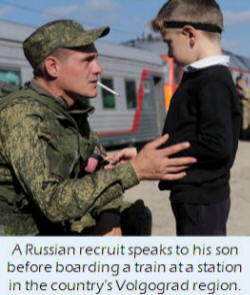 German-speaking minority in Belgium? What if Malta asked to join NATO but
officials were afraid it might make France mad? Or the EU was afraid admitting
Iceland might upset the UK?
International law recognizes and respects a country’s right to make its own
foreign policy decisions. International law recognizes and respects a country’s
sovereign boundaries, without regard as to whether another country agrees with
them. If a country disagrees with recognized boundaries, there are international
procedures in place to deal with boundary disputes. Military invasion is not an
acceptable policy except under very narrow circumstances. By overlooking
Russia’s long list of international crimes with regard to the sovereignty of
other countries and responding with only tough talk, the West lends credibility
to Moscow’s claims that its neighbors are somehow not entirely sovereign, that
they really belong to Russia. The logical continuation of this process is that
Russia’s ambitions toward all the countries of the former Russian empire will
succeed. Moscow believes it can do anything in those countries with impunity
because, so far, it has.
German-speaking minority in Belgium? What if Malta asked to join NATO but
officials were afraid it might make France mad? Or the EU was afraid admitting
Iceland might upset the UK?
International law recognizes and respects a country’s right to make its own
foreign policy decisions. International law recognizes and respects a country’s
sovereign boundaries, without regard as to whether another country agrees with
them. If a country disagrees with recognized boundaries, there are international
procedures in place to deal with boundary disputes. Military invasion is not an
acceptable policy except under very narrow circumstances. By overlooking
Russia’s long list of international crimes with regard to the sovereignty of
other countries and responding with only tough talk, the West lends credibility
to Moscow’s claims that its neighbors are somehow not entirely sovereign, that
they really belong to Russia. The logical continuation of this process is that
Russia’s ambitions toward all the countries of the former Russian empire will
succeed. Moscow believes it can do anything in those countries with impunity
because, so far, it has.
In 2022, against all expectations, the West’s response to the Russian invasion of Ukraine was both united and resolute. Economic sanctions and military support were thorough and fairly swift. However, as the war has continued to drag on with little lasting advantage on either side, Western leaders have begun to repeat that they will not directly engage with Russian forces so as not to further escalate the war. The West’s restraint, though, sends an unwanted message to Russia and the rest of the world: A nuclear power can carry out unprovoked, large-scale military operations against sovereign countries with immunity. Russia’s status as a nuclear power no doubt plays a role but so does Western aversion to using force. It’s even possible that the first factor is a smoke screen for the second. For decades the West has, in the name of security, spent billions on its military - rather than on health, education, poverty and so on - but a high-price military doesn’t increase security if the West has no intention of using it. Pursuing peace is important and noble but won’t work with an opponent who doesn’t care about peace. And, as it has proven several times, If Russia isn’t defeated, its aggressiveness will escalate. Moscow’s path is a long-term confrontation with the West that won’t stop in Ukraine.
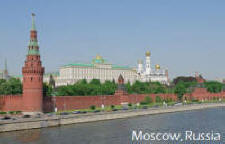
The Moscow-Beijing axis sees the war in Ukraine as a strategic blow against a world order still dominated by the free West. The more Russia and China feel that the rest of the world is only paying lip service to the West, the more incentive they will have to further undermine and change the current world order. Too, China will likely draw conclusions from Ukraine with regard to its own plans in Taiwan … and that’s a truly frightening thought. The West’s current strategy seems aimed at creating the conditions for a slow Russian non-victory. As the conflict drags out, though, there is a growing risk of divisions developing within (Shame on the US House for playing politics with the Ukrainian people!) and between Western countries regarding a course of action. What the West should be seeking is a decisive Russian defeat.
A prolonged conflict without a real conclusion, a Ukrainian defeat confirming the validity of Moscow’s strategy, or a partitioning of Ukraine under which the Russians would secure the most strategic areas, will leave a once-sovereign country in ruins and subjugation, will send a message to all struggling democracies that the West is not reliable, and will signal Moscow (and likely Beijing) that the West is no longer a threat.
5. Republic of Armenia is a Christian state more or less surrounded by Muslim states and views Russia as an important ally. Since its independence, Armenia has maintained a policy of trying to have positive and friendly relations with Iran, Russia and the West, including the US and the EU. Armenia is a parliamentary republic and considered the most democratic country in the Caucasus region but poverty, high unemployment rates, corruption and inadequate public services remain problematic.
6. Republic of Belarus remains an authoritarian state with a communist (and failed) economy and is increasingly dependent on Russian support. Belarus has provided Russia with a major strategic advantage in its war against Ukraine, although it has not so far been drawn into the fighting. Belarus's involvement in the war has significantly raised tensions with NATO allies to the west, including Latvia, Lithuania and Poland. The strategic partnership between Belarus and Russia is based on geographic location, close historic and cultural links, economic ties and cooperation between Belarusian and Russian businesses.
7. Georgia deported four suspected Russian spies in 2006, after which Russia began a full-scale diplomatic and economic war against Georgia and the persecution of ethnic Georgians living in Russia. In 2008, Russian troops invaded, claiming its support of two separatist Georgian regions, South Ossetia and Abkhazia. Russia still occupies the two areas but Georgia and the UN consider them part of Georgia. Since 1991, Georgia has made impressive progress fighting corruption, developing modern state institutions, and enhancing global security. It is a parliamentary representative democratic republic with a multi-party system. Many experts believe the tepid response of the UN and the West to Russia’s invasion of and continued presence in Georgia encouraged Russia’s later actions in Ukraine.
8. Republic of Moldova is home to a breakaway eastern region, Transnistria, that has strong Russian ties. Russian troops have been in Transnistria since the early 1990s, with their main tasks, according to Moscow, being peacekeeping and protecting ammunition depots. Moldova has repeatedly asked them to leave, saying their unauthorized presence breaches the country's sovereignty and neutrality. Moldava is a parliamentary representative democratic republic with a multi-party system but pervasive corruption in the government sector, links between major political parties and powerful economic interests, and major deficiencies in the rule of law continue to hamper democratic governance. In the past three years, Moldova has elected a pro-European president and government and has started procedures to join the EU. Again, experts believe the tepid response of the UN and the West to Russia’s invasion of and continued presence in Moldava has encouraged Russia’s aggressive actions toward other countries.
9. Ukraine was invaded by Russia in February 2022. The invasion became the largest attack on a European country since WWII. Russia’s plan had been to seize Kyiv in a matter of days and to install a pro-Moscow government but Ukraine mounted an unexpectedly determined defense and, eventually with Western support, was able to halt the Russian advance. The war is on-going as of March 2024. In 2014 Russia invaded and annexed Ukraine’s Crimean Peninsula. Ukraine considers Crimea to be part of its territory that is currently under occupation, as does the UN. The UN and the West typically offered little response beyond saber-rattling to Russia’s annexation of Crimea. However, the response to Russia’s 2022 invasion was unexpectedly wide-spread and supportive, although it is becoming less enthusiastic over time.
Political Resources on the Net
Google's Arts & Culture collection virtual world museum tours

Legend says Armenia, a mountainous country in the South Caucasus mountains, was established in the Ararat region on which Noah's Ark is said to have come to rest after the flood, by the great-great-grandson of Noah. True or not, few nations have histories as ancient, complex and laced with tragedy as Armenia. Yerevan, the capital city of Armenia, is home to Etchmiadzin Cathedral. Armenia's Mother Church, traditionally dated 303 CE, is considered the oldest cathedral in the world. Khor Virap, an ancient monastery, is the perfect place to observe Mount Ararat. | A mountain village beckons in Nagorno-Karabakh | Culture | You might be interested in The Promise (2016, 2:14), which is set during the final years of the Ottoman Empire and during the Armenian genocide that took place. | For Nagorno-Karabakh’s Dueling Sides, Living Together Is ‘Impossible’ | Azerbaijan Begins a Military Operation in the Armenian Enclave of Nagorno-Karabakh | Understanding the Dispute Between Armenia and Azerbaijan
Belarus | History and geography | Belarus: Independent voice wins Nobel Prize | Human Rights Watch: Belarus | Culture | Take a trip to Belarus, and visit an often overlooked country that gained its independence from the USSR in 1991 but is forming close economic and political ties to Russia. | Who'd be an MP in Europe's last dictatorship?
Chechnya (or Chechen Republic), a region in North Caucasus, has been home to a violent and long-running rebel campaign to break away from Russia. | Borderless Blogger: A bridge to the Chechen people | Historical and natural monuments of mountainous Chechnya | The views of Grozny city rebuilt after the war | History and geography | Human Rights Watch: Chechnya | Robinson Library: Republic of Chechnya | Black Widows | The conflict between Russia and Chechnya | The Story Behind a Chechen Wedding That Transfixed Russia and Beyond
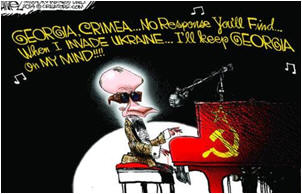
Travel to Georgia. Or,
here. Along with
Armenia and
Azerbaijan,
Georgia is located in the Caucasus
 Mountains
area that divides Russia from Central Asia. Ethnic Georgians make up the
majority of the population. The
About Georgia website was developed by a librarian in Georgia to tell others
around the world about his homeland. It contains some interesting information
about the country as well as the Georgian Constitution and information that
might be of interest to a visitor. It also has links to several other sites
relating to Georgia. Some of it is still under construction and only available
in either Russian or Georgian. |
Vegan cafe in Tbilisi, Georgia, stormed by group armed with sausages, meat and
fish |
Georgia needs support from the US and the West | If you’re interested in the
2008 Russian invasion of Georgia, catch a re-run of 2011’s 5 Days of War
(153 min) … very good
Mountains
area that divides Russia from Central Asia. Ethnic Georgians make up the
majority of the population. The
About Georgia website was developed by a librarian in Georgia to tell others
around the world about his homeland. It contains some interesting information
about the country as well as the Georgian Constitution and information that
might be of interest to a visitor. It also has links to several other sites
relating to Georgia. Some of it is still under construction and only available
in either Russian or Georgian. |
Vegan cafe in Tbilisi, Georgia, stormed by group armed with sausages, meat and
fish |
Georgia needs support from the US and the West | If you’re interested in the
2008 Russian invasion of Georgia, catch a re-run of 2011’s 5 Days of War
(153 min) … very good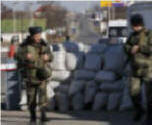 |
Tbilisi Georgia Cam |
A Glimpse inside the Secluded World of a Georgian Convent
|
Tbilisi Georgia Cam |
A Glimpse inside the Secluded World of a Georgian Convent
Moldova | One of the poorest nations in Europe and situated between Romania and Ukraine, Moldova is a melting pot of ethnicities and cultures and has long been a geopolitical battleground … threatened by the east and forgotten by the west. Although independent from the USSR since 1991, Russian forces have remained on Moldovan territory east of the Nistru (Dnister) River “supporting” the Slavic majority population, mostly Ukrainians and Russians, who have proclaimed a Transnistria republic. | Moldova, the Next Ukraine | The Demons of Moldova | Letter from: Chişinău, the Moldovan city with an uncertain future | Could Moldova Be The Next Crimea?
Russian Federation Social-Economic Regions provides access to information organized on the basic regions of modern day Russia. It includes several maps, access to topography, and information about each of the republic centers. Clicking on the links brings up general information about that center as well as additional links to information about the area, including history and current issues. | Russia 'must' do this. Russia 'must' do that. Or else what? | How Vladimir Putin is building alliances around the world | Bucknell University’s Russian Studies Material | Collapse of the USSR 10 years on | Russia's naval base in Ukraine: Critical asset or point of pride? | Russian forces in Ukraine: What does the Black Sea Fleet in Crimea look like? | Surveys show Russian nationalism is on the rise | Where the river runs red: can Norilsk, Russia's most polluted city, come clean? | Putin's paranoia: fear and loathing inside the Kremlin | The USSR in 10 buildings: Constructivist communes to Stalinist skyscrapers | Slow-motion wrecks: how thawing permafrost is destroying Arctic cities | Dirty, isolated and freezing: life in Arctic circle city – in pictures | Wild Russia (47:07) is a journey about nature across this enormous land that goes from Europe to the Pacific Ocean. | Take a virtual tour along the Ket River in Siberia, home to a range of solitary settlements.
The new Russia and freedom of religion: The survival of animism in Russia, and its destruction in the West | Actually, the Russian state and church did persecute pagans. | Threats to Mari Animism | Putin vs. Democracy: Democracy is on the decline worldwide and Vladimir Putin is a big factor. | The Russian Empire Must Die | Russia’s Dangerous Decline | Putin's Empire Starts to Crumble | Russian Women Get a Fresh Warning about Their Rights | How Western Scholars Overlooked Russian Imperialism
Moscow is the capital and most populous city of Russia. The city is also the
major political, economic, cultural, religious, financial, educational and
transportation centre of Russia. It is located by the
Moskva River in the European part of Russia. Moscow is the world's most
populated inland city, as well as the northernmost and coldest megacity on
earth. The city is well known for its architecture, particularly its historic
buildings such as
Saint Basil's Cathedral with its brightly colored domes. With over 40% of
its territory covered by greenery, it is one of the
greenest capitals and major cities in the world, having the
largest forest in an urban area within its borders. The city has served as
the capital of a progression of states, from the medieval Grand Duchy of Moscow
and the subsequent Tsardom of Russia to the Soviet Union and the contemporary
Russian Federation. | Explore the
capital of the Russian Federation with its rich and varied culture. | The Kremlin
is the seat of government for the old Soviet Union and for
the new Russian Federation. Take a look at
The Kremlin and enjoy everything from panoramic views of
Red Square to a 3-D layout of the Kremlin itself. |
Moscow Russia Cam
Russia. It is located by the
Moskva River in the European part of Russia. Moscow is the world's most
populated inland city, as well as the northernmost and coldest megacity on
earth. The city is well known for its architecture, particularly its historic
buildings such as
Saint Basil's Cathedral with its brightly colored domes. With over 40% of
its territory covered by greenery, it is one of the
greenest capitals and major cities in the world, having the
largest forest in an urban area within its borders. The city has served as
the capital of a progression of states, from the medieval Grand Duchy of Moscow
and the subsequent Tsardom of Russia to the Soviet Union and the contemporary
Russian Federation. | Explore the
capital of the Russian Federation with its rich and varied culture. | The Kremlin
is the seat of government for the old Soviet Union and for
the new Russian Federation. Take a look at
The Kremlin and enjoy everything from panoramic views of
Red Square to a 3-D layout of the Kremlin itself. |
Moscow Russia Cam
Saint Petersburg (formerly Petrograd, then Leningrad) is often described as
the most Westernized city of Russia, as well as its cultural capital. Located on
the
Neva River at
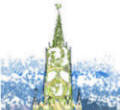 the
head of the
Gulf of Finland on the Baltic Sea, it is the northernmost city in the world
with a population of over one million. In 1611, Swedish colonists built a
fortress at the mouth of the Neva River. A small town grew up around it.
Peter the Great was interested in seafaring and maritime affairs, and he
intended to have Russia gain a seaport in order to be able to trade with other
maritime nations. In 1703, during the
Great Northern War, Peter the Great captured the town and built the
Peter and Paul Fortress, which became the first brick and stone building of
the new city. The city was
built by conscripted peasants from all over Russia. Tens of thousands of
serfs died building the city. Peter moved the capital from Moscow to
Saint Petersburg in 1712. With one brief exception, it remained Russia’s
capital until the communist revolution of 1917. |
Russian cities
the
head of the
Gulf of Finland on the Baltic Sea, it is the northernmost city in the world
with a population of over one million. In 1611, Swedish colonists built a
fortress at the mouth of the Neva River. A small town grew up around it.
Peter the Great was interested in seafaring and maritime affairs, and he
intended to have Russia gain a seaport in order to be able to trade with other
maritime nations. In 1703, during the
Great Northern War, Peter the Great captured the town and built the
Peter and Paul Fortress, which became the first brick and stone building of
the new city. The city was
built by conscripted peasants from all over Russia. Tens of thousands of
serfs died building the city. Peter moved the capital from Moscow to
Saint Petersburg in 1712. With one brief exception, it remained Russia’s
capital until the communist revolution of 1917. |
Russian cities
Considered the deepest lake in the world, Lake Baikal, located in east central Siberia, is one of the largest lakes in Eurasia. | Surviving in Isolation, Where the Steppe Has Turned to Sand | Reindeer at the End of the World
In April 1986, the nuclear reactor at Chernobyl, Ukraine, suffered a catastrophic accident. It is hard for most of us to grasp the magnitude of this event, but it has been estimated that nearly 50 tons of radioactive material were released at Chernobyl, 10 times the fallout of Hiroshima. The effects of the accident will be felt for many years to come. See also the US Department of Energy.
Seconds From Disaster - Meltdown at Chernobyl (47:08)
Ukraine is passing through a choppy period in its post-independence story and one which is fascinating to watch. History is everywhere in this vast land, whether it be among the Gothic churches of Lviv, the Stalinist facades of Kyiv, the remnants of the once-animated Jewish culture of West Ukraine or the more recent Soviet high-rises just about anywhere. | Defiant Ukrainian soldiers sing national anthem as Russian troops storm their base in Crimea | For Ukraine, an independence day marked by deep public frustration | Kyiv Post | The Scattering of Ukraine's Jews | Using Adoptions, Russia Turns Ukrainian Children into Spoils of War | What We’re Reading About One Year of War in Ukraine
Ukraine |
The city of
Sevastopol is located on
Heraclea Peninsula in the southwestern part of the
Crimea. In the 5th century BCE the prosperous
 Greek
colony of
Chersoneses was located on this spot. Today it is the main
Russian Navy
Port on the Black Sea and the largest port on the Black Sea, as well as an
industrial hub and a center for science, technology, history, culture and
recreation. As a result of the 2014 annexation of Crimea by Russia, the city is
administered as a federal city, although
Ukraine and most of the international community continue to regard Sevastopol as
a city within Ukraine. Relatively small at 334 square miles, Sevastopol's
unique naval and maritime features provide the basis for a robust economy. The
city is an important center for marine biology; in particular, dolphins have
been studied and trained in the city since the end of WWII. |
Ukraine crisis: why Russia sees Crimea as its naval stronghold |
Ukraine's residents struggle to survive (2:30) |
The volunteer war fighters of Ukraine (2:46) |
Ukraine's sharp divisions|
Why Crimea is so dangerous |
The shortsightedness of NATO's war with Serbia over Kosovo haunts Ukraine |
Crimea is not Kosovo |
How Russia’s Military Is Positioned to Threaten Ukraine (01/07/2022) |
This video shows the scale of Russia’s military buildup around Ukraine
(02/2022). |
What does Russia want in Ukraine? Explore the
causes of the conflict and the history
of the relationship between the two countries. |
How Seriously Should We Take Putin’s Nuclear Threat in Ukraine?
Greek
colony of
Chersoneses was located on this spot. Today it is the main
Russian Navy
Port on the Black Sea and the largest port on the Black Sea, as well as an
industrial hub and a center for science, technology, history, culture and
recreation. As a result of the 2014 annexation of Crimea by Russia, the city is
administered as a federal city, although
Ukraine and most of the international community continue to regard Sevastopol as
a city within Ukraine. Relatively small at 334 square miles, Sevastopol's
unique naval and maritime features provide the basis for a robust economy. The
city is an important center for marine biology; in particular, dolphins have
been studied and trained in the city since the end of WWII. |
Ukraine crisis: why Russia sees Crimea as its naval stronghold |
Ukraine's residents struggle to survive (2:30) |
The volunteer war fighters of Ukraine (2:46) |
Ukraine's sharp divisions|
Why Crimea is so dangerous |
The shortsightedness of NATO's war with Serbia over Kosovo haunts Ukraine |
Crimea is not Kosovo |
How Russia’s Military Is Positioned to Threaten Ukraine (01/07/2022) |
This video shows the scale of Russia’s military buildup around Ukraine
(02/2022). |
What does Russia want in Ukraine? Explore the
causes of the conflict and the history
of the relationship between the two countries. |
How Seriously Should We Take Putin’s Nuclear Threat in Ukraine?
There are lots of pictures so it may take a minute for the page to open!
|
|